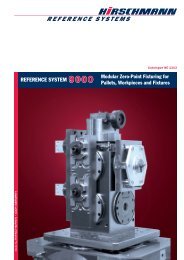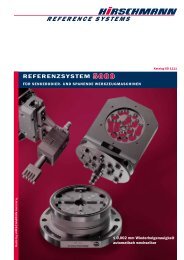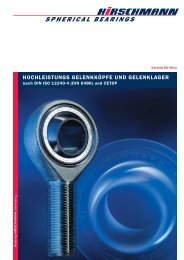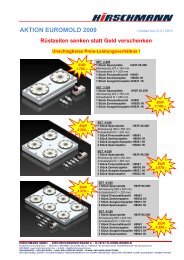heavy-duty rod ends and spherical bearings - Hirschmann GmbH
heavy-duty rod ends and spherical bearings - Hirschmann GmbH
heavy-duty rod ends and spherical bearings - Hirschmann GmbH
Create successful ePaper yourself
Turn your PDF publications into a flip-book with our unique Google optimized e-Paper software.
Operating temperature:<br />
All designs can be used without restriction in a temperature<br />
range from –30° C to +120° C. Increasing the operating<br />
temperature reduces the bearing power <strong>and</strong>, thus, the<br />
service life.<br />
Operation at high temperature of relubricatable <strong>rod</strong> <strong>ends</strong><br />
<strong>and</strong> <strong>spherical</strong> <strong>bearings</strong> dep<strong>ends</strong> to a very great extent on<br />
whether the high-temperature lubricating grease used offers<br />
sufficient lubricity at high operating temperatures.<br />
These designs could be used in the short term under low<br />
load <strong>and</strong> with suitable lubrication at temperatures up to<br />
+250° C.<br />
The maintenance-free <strong>bearings</strong> can be used in a temperature<br />
range from –50° C to +150° C (mind the decrease or<br />
the increase of bearing slackness).<br />
Sealed <strong>rod</strong> <strong>ends</strong> <strong>and</strong> <strong>spherical</strong> <strong>bearings</strong> can be used at<br />
temperatures from –20° C to +120° C (sealing sleeves of<br />
Perbunan). For higher temperatures up to +250° C sealing<br />
sleeves can be specially made from fluorelastomer<br />
rubber (Viton ® ).<br />
Moment of friction M:<br />
The moment of friction for <strong>rod</strong> <strong>ends</strong> <strong>and</strong> <strong>spherical</strong> <strong>bearings</strong><br />
can be calculated using the following equation:<br />
M = 5 · 10 -4 · μ · P · K<br />
M = moment of friction [Nm]<br />
μ = friction coefficient of sliding surface<br />
P = dynamically equivalent bearing load [N]<br />
K = inner ring diameter [mm]<br />
Guideline values for the friction coefficient μ<br />
Friction coefficient μ<br />
Bearing type min max<br />
lubricated 0,08 0,15<br />
maintenance-free 0,03 0,10<br />
Fig. 3<br />
The low friction coefficients apply for high loads<br />
(p = 80–100 N/mm 2) at low running speeds<br />
(v = 5–10 m/min). The high friction coefficients are for<br />
low loads (p = 5–10 N/mm 2) at high running speeds<br />
(v = 30–60 m/min).<br />
p = specific surface pressure [N/mm 2]<br />
v = running speed in the lining [m/min]<br />
Viton ® is a registrered trademark of Du Pont Performance<br />
Elastomers.<br />
Bearing capacities:<br />
The dynamic bearing capacity C:<br />
The dynamic bearing capacity C is a characteristic value<br />
for the calculation of the service life of <strong>rod</strong> <strong>ends</strong> <strong>and</strong><br />
<strong>spherical</strong> <strong>bearings</strong> under dynamic load, i.e. having to perform<br />
tilting, swinging or pivoting movements under load.<br />
The dynamic bearing capacity C is based on the values<br />
given in the table for the specific surface pressure k c :<br />
Type of bearing Specific surface pressure kc [N/mm2] lubricated 50<br />
maintenance-free 150<br />
Fig. 4<br />
The static bearing capacity C o :<br />
The static bearing capacity C o represents the maximum<br />
permissible load at which no permanent deformation of<br />
the lining or the outer part occurs. In the case of the<br />
<strong>spherical</strong> bearing, the surrounding components must be<br />
so designed that they prevent any deformation of the bearing.<br />
In the case of <strong>rod</strong> <strong>ends</strong>, C o corresponds to the permissible<br />
load based on the weakest cross-section which results<br />
form the yield point of the outer material, with a safety<br />
factor of 1,2.<br />
The ultimate load is at least 1.5 the permissible C o load.<br />
The axial load-bearing capacity:<br />
The axial load-bearing capacity of the <strong>rod</strong> <strong>ends</strong> <strong>and</strong> the<br />
<strong>spherical</strong> <strong>bearings</strong> is limited by the axial fixing of the bushing<br />
(flanged) in the outer part.<br />
In the case of <strong>spherical</strong> <strong>bearings</strong> without steel outer ring<br />
(types SC.. <strong>and</strong> SCP..), it must be ensured that the axial<br />
bushing support can absorb the forces given in the table<br />
(Fig. 5) both statically <strong>and</strong> dynamically.<br />
The maximum permissible axial load is calculated on the<br />
basis of the values given in the table.<br />
Heavy-<strong>duty</strong> <strong>and</strong> Permissible axial load<br />
maintenance-free dynamic static<br />
series<br />
SFC/SMC/SSC..<br />
Fa perm. [N] Fa perm. [N]<br />
SFRC/SMRC/SSRC.. 0,06 · Co 0,3 · Co SFXC/SMXC/SC.. 0,04 · Co 0,2 · Co Fig. 5<br />
7






